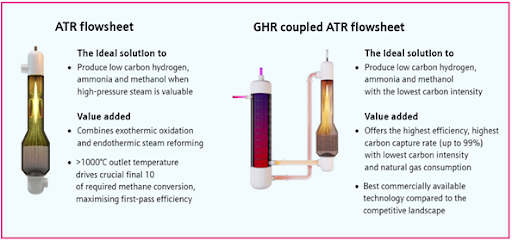-
The importance of CCS-enabled hydrogen in the energy transition
Date posted:
-
-
-
Post Author
Greg Kelsall
-
-

The global demand for clean hydrogen is increasing as nations strive to transition to sustainable energy systems. There are several pathways to produce clean hydrogen, including electrolysis using renewable energy, or from natural gas with CCS (often called blue-hydrogen). Countries are investing heavily in hydrogen infrastructure, with ambitious projects and collaborations emerging worldwide. The European Union, Japan, South Korea, and Australia lead the charge, establishing hydrogen strategies and funding research and development. This growing commitment underscores hydrogen’s essential role in achieving net-zero emissions and fostering a sustainable, resilient energy future. The IEA, amongst others, estimates that around 450 MtH2/y will be required by 2050 to achieve a successful energy transformation. To address the need for the significant increases in hydrogen production required to meet decarbonisation targets, CCS-enabled hydrogen will need to play a considerable part, certainly in the near to medium term.
One of the leading technology providers for low-carbon hydrogen is Johnson Matthey. According to the company, its LCH™ technology can capture up to 99% of CO₂ emissions generated during hydrogen production. Compared to traditional steam methane reforming (SMR) methods, it offers efficiency, cost-effectiveness and a significant reduction in plant CAPEX and OPEX requirements.
SMR and advanced gas reforming (AGR) are the principal CCS-enabled hydrogen production technologies. AGR consists of either an Autothermal Reformer (ATR) or an ATR coupled with a Gas Heated Reformer (GHR). Where there is a requirement to capture CO₂, it is recognised that AGR is a more appropriate technology for the generation of CCS-enabled hydrogen due to its provision of a more suitable stream for CO₂ capture.
The technology of a plant using LCH technology
Purified natural gas is first pre-heated and reformed in the GHR before entering the ATR. In the GHR, 30% of the hydrocarbons react with steam to form syngas. Next, oxygen is added to the ATR, causing some partially reformed gas to combust and raise the process gas temperature. This gas then passes through a reforming catalyst bed within the same vessel for further reforming. Operating at high temperatures and steam flows minimises the methane content of the product gas exiting the reformer, as equilibrium limits the reaction. Any residual methane at this stage will increase overall CO₂ emissions. The hot gas leaving the ATR returns to the GHR, supplying the necessary heat for the reforming reaction in the GHR.
The critical difference between the LCH technology and SMR flowsheets is the source of energy driving the reaction. With LCH technology, oxygen is introduced to the ATR, which can be supplied by an air separation unit (ASU). An SMR, on the other hand, relies on burning natural gas. An air separation unit (ASU) can supply the oxygen for the ATR. Combustion with oxygen provides the required heat for reforming. Significantly, the ATR operates at temperatures above 1000°C, enhancing the conversion of hydrocarbons and reducing methane slip.
The technology of GHR- The efficiency of a flowsheet is closely tied to its ability to manage energy, particularly exergy, which measures energy’s potential to perform work. The key is minimising combustion and reducing the thermal gradients over which heat is transferred. Johnson Matthey’s LCH technology exemplifies these principles by incorporating a GHR. This reduces the combustion needed for converting hydrocarbons to carbon oxides and minimises thermal gradients by transferring heat into endothermic reforming reactions within the GHR. This approach maximises energy efficiency, which is essential for sustainably producing hydrogen.
In the LCH technology, the GHR works alongside an ATR, enhancing energy efficiency. The GHR, a heat exchange reformer, performs chemical reactions in its tubes, reducing combustion requirements compared to a solely ATR-based system. This maximises exergy and reduces oxygen needs, allowing for smaller ASUs.
Furthermore, the LCH technology configuration offers a 10% reduction in natural gas consumption and CO₂ capture duty per unit of hydrogen produced. This results in smaller, more efficient operations and improved carbon efficiency.
